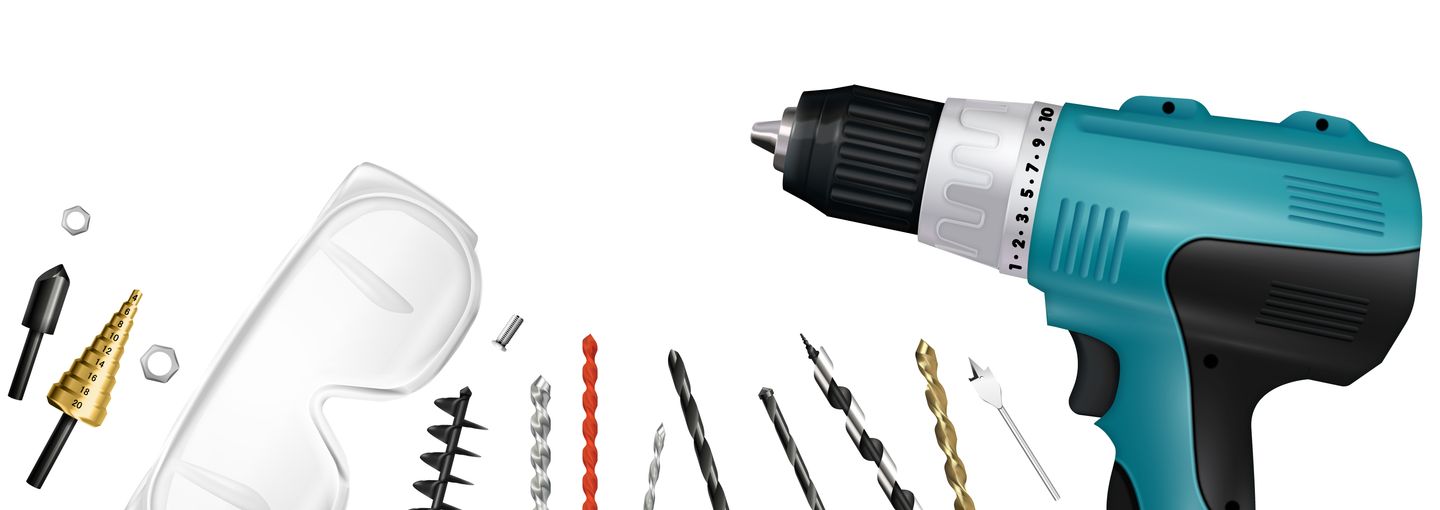You’ve finally got round to that DIY project you have been planning. (applause all round)
You may already have your safety goggles on and a drill in your hand, but now you are questioning, “what drill bit do I need?”.
Before you reach for the wrong one, it’s important to understand that the incorrect drill bit can be problematic.
Not only can it lead to a job taking longer than necessary, but having the wrong drill bit can leave you with damaged materials & tools, and it can also be a safety hazard.
In this blog, we will talk you through choosing the right drill bit, whether you're putting up a shelf, hanging a mirror or putting furniture together.

What material are you drilling into?
When it comes to selecting the right drill bit, you'll need to know what surface material you are drilling into.
Sounds simple enough but not everyone does it.
Not every drill bit suits all materials.
You can buy multi-purpose drill bits for a variety of substances, however, the quality will diminish more quickly than those designed to tackle specific tasks.
Here are the type of drill bits needed for different materials.
What drill bit is needed for brick?
Brick, stone or concrete are tough materials so they'll need a drill bit that's strong enough to cut through it.
A masonry drill bit is perfect for using on brick as they are usually made from High Speed Steel.
They have an incredibly tough carbide tip to allow it to penetrate through brick, stone & concrete with ease.
You'll need to make sure the masonry drill bits are the right shape to prevent cracks and splits as you drill.
SDS drills are designed for heavy duty drilling which makes them ideal for masonry work.
What drill bit is needed for tiles?
When you're drilling into tiles, the drill but you need depends on the type of tile you're using.
For porcelain tiles, the best drill bit is a diamond tipped bit.
Diamond tipped drill bits have been designed to cut through porcelain without chipping or cracking the tile.
For ceramic tiles, you can use ceramic drill bits as well as diamond drill bits.
What drill bit is needed for metal?
To work on metal, you’ll need to use high-speed steel (HSS) bits, black oxide bits, cobalt steel bits and titanium bits.
Metal drill bits with a cone shaped tip are designed to drill into metal like aluminium, copper or brass.
A cobalt steel drill bit is for drilling through tough stainless steel.
HSS drill bits are designed to drill through soft metals & for thin sheet metals, step drill bits are perfect for the job.
Although they can withstand the heat generated from drilling into metal, it’s still a good idea to use drilling fluid to maintain the drill bit’s longevity.
What drill bit is needed for plasterboard?
You have to be careful which drill bit you use on plasterboard, as not all bits will be suitable.
When installing plasterboard around your home, a regular multi-purpose or wood drill bit will work well, so stick with those.
Masonry or metal drill bits are far too powerful to use as they'll damage the plaster, so make sure you avoid using those types.
What drill bit is needed for wood?
Whether you’re fitting hinges in a door frame or putting wooden furniture together, you’ll ideally use an auger bit.
It has a corkscrew design that easily penetrates through wood leaving a neat finish on the edges of the hole.
If a neat and tidy finish is important you may want to use a countersink drill bit that leaves the flat-head screw sitting flush with the wood.
What size drill bit do I need?
After determining the material you will be drilling into, you'll need to work out what size hole you need to make.
Having the right size drill bit will prevent any slippage when driving the bit or screw.
You should use a drill bit that is slightly smaller than the screw you intend to use - for example if you are using a 4.5mm screw then use a 4mm drill bit.
You can use this quick video guide to picking the right drill bit size if you aren't sure on the size of your screw.
If you are looking to anchor a wall plug, you can work out their size by their colour.
Use this as a general guide to work out what size bit you will need:
For yellow wall plugs use a 4mm bit
For red wall plugs use a 5.5mm bit
For brown wall plugs use a 7mm bit
If you are looking to create bigger holes for cabling or pipes, you will need a specialist drill bit called a hole saw.
Be sure to check the description carefully to see which materials the hole cutter can tackle.

Choose the right drill bits with HSS DIY
And there you have it!
Choosing the right drill bit is easier than you think.
Not all drill bits are suitable for multi-use, so it's important you have the right one so you don't damage your materials.
From masonry drill bits, to diamond, auger & high-speed steel drill bits, they all serve a purpose and will make drilling more efficient & safe.
HSS DIY has a wide range of drill bits that you can buy for your projects.
For any help or advice regarding which drill bit is right for you, get in touch with our live chat team or pop in to your local HSS branch.






















































